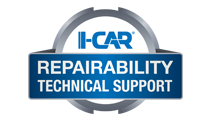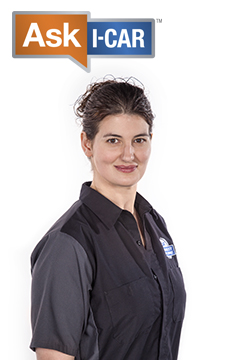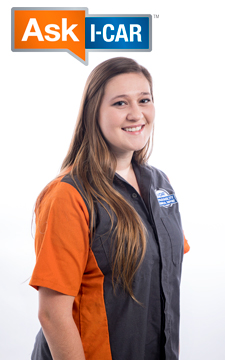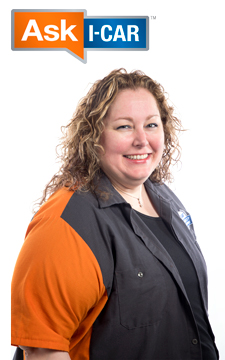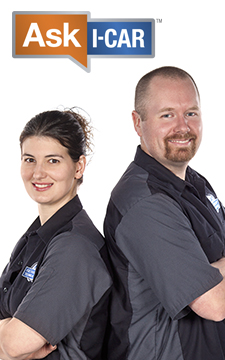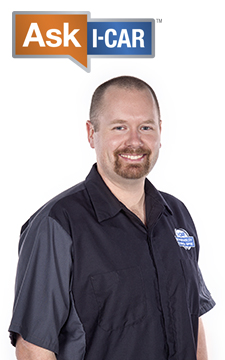Body Repair Manual Symbols: Hyundai
Posted on 17 December 2025While looking at repair procedures in a body repair manual (BRM) you may notice that symbols are used to indicate specific operations or parts to be used during the repair process. Most BRMs provide a glossary or a chart that explains these symbols.
Hyundai Position Statement: Pre- And Post-Repair System Scanning - UPDATE
Posted on 23 June 2025Hyundai released an updated position statement relating to pre- and post-repair system scanning.
Refinishing Park Assist Sensors: Hyundai
Posted on 7 March 2025Park assist sensors are part of the park assist system, just one of many advanced driver assistance systems (ADAS) found on vehicles today. Damaged sensors are typically replaced and may require painting to match the vehicle. Vehicle makers often provide information on the painting of new sensors. Some vehicle makers do not recommend refinishing sensors with minor finish damage because excessive paint thickness may adversely affect the operation of the park assist system. However, other vehicle makers allow refinishing and provide guidelines. Let’s see what Hyundai has to say.
Bumper Cover Repair With ADAS: Hyundai - UPDATE
Posted on 27 February 2025A simple bumper repair on a modern vehicle may not be as simple as it seems. New technologies like blind spot monitoring, adaptive cruise control, and other advanced driver assistance systems (ADAS) utilize sensors behind the bumper covers. The ability for these sensors to be able to see clearly requires special caution when considering a bumper repair. Many OEMs have different requirements when it comes to repairing bumper covers with ADAS. So, what does Hyundai say on the subject?
Hyundai/Genesis Releases Use Of Heat Position Statements
Posted on 31 January 2025Hyundai and Genesis released position statements about the use of heat. Let’s take a look at the position statements.
Hyundai/Genesis Releases Bumper Cover Repairability Position Statements
Posted on 31 January 2025Hyundai and Genesis released position statements about repairing bumpers with advanced driver assistance systems (ADAS) sensors.
I-CAR Repairers Realm: Top 5 I-CAR RTS Linking Pins Of 2024 - Now Available
Posted on 2 January 2025I-CAR had a discussion on the top 5 I-CAR RTS linking pins of 2024.
I-CAR OEM Technical Information Matrix: What Is It, And How Does It Help? UPDATE
Posted on 5 December 2024Do you know which vehicle makers have collision repair information available? Do you know where you can go to find that out?
High-Voltage Handling And Storage Considerations: Hyundai - UPDATE
Posted on 11 July 2024High-voltage (HV) vehicles have some special considerations for handling and storing HV batteries and other components. The dangers of HV batteries are potential even after removal which is why certain precautions are needed. Let’s see what Hyundai has to say.
I-CAR Repairers Realm: Vehicle Highlights From The Chicago Auto Show - Now Available
Posted on 3 July 2024I-CAR had a discussion on vehicle highlights from the 2024 Chicago Auto Show.
Hyundai Position Statement: High-Voltage Battery Inspection And Replacement After Structural Damage
Posted on 22 May 2024Hyundai released a position statement relating to high-voltage (HV) battery inspections.
Repairer Driven News: ADAS Radar Optimized Paint Color Resources
Posted on 12 April 2024Changes in advanced driver assistance systems (ADAS) radar technology are introducing new refinishing considerations. We know that paint film thickness can affect the performance of ADAS radars, but color formula selection may also be a contributing factor. What resources do repairers have available? Let’s see what Repairer Driven News (RDN) has available.
High-Voltage Vehicle Paint Booth Quick Reference
Posted on 9 April 2024When refinishing high-voltage (HV) vehicles, it is important to check for OEM paint booth temperature recommendations so that HV components do not get damaged in the heat.
I-CAR Hyundai Collision Repair And Electromechanical Repair Courses
Posted on 14 February 2024I-CAR has developed courses that go into detail on electromechanical repair for Hyundai and a general collision repair overview as well.
Hyundai/Genesis Releases Additional Body Repair Manuals: UPDATE
Posted on 14 September 2023Hyundai Motor America updated their approved body repair manuals (BRMs) available to the United States market. This includes both Hyundai and Genesis branded BRMs.
Calibration Research Tips: Hyundai/Genesis Driver Parking Assistance System
Posted on 25 May 2023While searching for information on advanced driver assistance systems (ADAS) on an OEM repair information site, you may come across unique calibration procedures or events. These events can vary by year and model, even within a particular make. As the RTS team has been researching these systems, we have been identifying these atypical circumstances. In order to help you better understand them, we are putting together a series of articles that help with the repair and calibration of ADAS. Let’s take a closer look at Hyundai.
Identifying The Correct Body Repair Manual: Hyundai/Genesis
Posted on 29 March 2023Vehicle makers may group their body repair manuals (BRMs) in several different ways. Sometimes the BRMs are grouped by a year range, some are listed as VIN specific, and others are arranged by a body code. Let’s take a look at Hyundai to see how they group their BRMs.
One-Time-Use Parts And Fasteners: Hyundai
Posted on 25 November 2022What is a one-time-use part, and how do you determine if a fastener, clip, or part can be reused? These are questions that we are confronted with in the collision industry quite a lot. The other big question is "Where do I find this information"?
Body Construction And Material Repair Guidelines: Hyundai
Posted on 20 October 2022What is the MPa of the front lower rail? What is the outer uniside made of: steel, aluminum, or composite? Can heat be used to straighten or is it cold straightening only? What are the repair limitations? These are just some of the questions that the RTS team fields on a daily basis.
Corrosion Protection Guidelines: Hyundai
Posted on 23 September 2022A key factor in collision repair is making long-lasting repairs. When a vehicle is repaired, many areas of corrosion protection are disturbed. This creates corrosion hot spots, that left untreated will lead to corrosion, and potentially a repair failure. However, there are certain precautions that can be taken to safely and properly restore the corrosion protection throughout the repair process. OEMs often give specifications on restoring corrosion protection. These specifications generally include seam sealer, adhesives, foam fillers, and cavity waxes. Let’s take a look at what Hyundai says.
Structural Sectioning Procedures: Hyundai
Posted on 3 August 2022Ask I-CAR receives many technical inquiries referring to sectioning. The collision repair industry wants to know where can you section, does the OEM have a sectioning procedure, and where can I find the sectioning procedure? Most OEMs allow sectioning to outer body panels and the front and rear rails. Sectioning reinforcements is not as common, as most reinforcements are replaced at factory seams.
Locating OEM-Approved HV Tools: Hyundai
Posted on 17 June 2022When researching procedures for disabling a high-voltage (HV) vehicle, you may notice that many of the procedures require the use of specific tools. Some of them are OEM-specific tools or scan tools. Often identifying and locating where to purchase these specific tools can be difficult.
The RTS team is researching how to find these tools to make it easier for technicians performing these tasks. As we research the location of these special tools, we are compiling the information in a series of OEM-specific articles.
Hyundai: Who Requires Or Recommends MIG Brazing?
Posted on 10 March 2022In Europe, MIG brazing has been required or recommended on a widespread basis for several years. In the U.S., MIG brazing is not as common but is becoming more prevalent. As the RTS team is researching MIG brazing information, we are putting together a series of articles that identify OEM-specific MIG brazing recommendations and requirements for vehicles in the U.S. Let’s see what Hyundai has to say.
Hyundai High-Voltage Technician Levels
Posted on 18 February 2022As electric-only, hybrid, and fuel cell electric vehicles are increasing in sales, they are becoming more commonplace in repair facilities. Along with the unique powertrains that come with these vehicles, also comes unique safety concerns. Regardless of vehicle maker, high-voltage (HV) systems pose a threat of injury or death if not handled properly. Only personnel with the proper training, PPE, tools, equipment, and service information should perform work on the HV systems.
OEM Emergency Response Guides: Hyundai
Posted on 28 January 2022Are you looking for OEM emergency response guides (ERGs)? The Repairability Technical Support (RTS) team has located these guides and either houses them on the RTS website, provides links to webpages that house them, or provides articles with instructions on how to locate them.
Locating OEM-Approved ADAS Tools: Hyundai
Posted on 10 December 2021When researching calibration procedures for advanced driver assistance systems (ADAS), you may notice that many of the procedures require the use of specific tools. Some tools may be everyday items like string, tape, levels, paper, etc. However, many of them are OEM-specific tools or scan tools. Often identifying and locating where to purchase these specific tools can be difficult.
Weld-Through Primer Guidelines: Hyundai
Posted on 22 June 2021Weld-through primers are generally a zinc-based product that are applied to the mating surfaces prior to welding. Corroding zinc forms zinc oxide which protects the steel. This is called sacrificial corrosion. For a quality weld to be made it’s required that the weld-through primer be removed from the direct weld zone before welding the joint when GMA welding. Many OEMs have a position on when and how to use weld-through primer or when it shouldn’t be utilized. Let’s see what Hyundai recommends and where this information can be found.
Steel Spot And Plug Weld Nugget Size: Hyundai - UPDATE
Posted on 8 April 2021Did you know that some OEMs specify nugget size for spot and plug welds? This information is typically found within vehicle-specific repair procedures or can be found under general welding guidelines. Let's see what Hyundai has to say.
OEM Emergency Response Guides
Posted on 25 February 2021Are you looking for OEM emergency response guides (ERGs)? The Repairability Technical Support (RTS) team has located these guides and either houses them on the RTS website, provides links to webpages that house them, or provides articles with instructions on how to locate them.
Who Requires Or Recommends MIG Brazing? UPDATE
Posted on 25 November 2020In Europe, MIG brazing has been required or recommended on a widespread basis for several years. In the U.S., MIG brazing is not as common but is becoming more prevalent. As the RTS team is researching MIG brazing information, we are putting together a series of articles that identify OEM-specific MIG brazing recommendations and requirements for vehicles in the U.S.
Where Do I Find Other Types Of Information In Hyundai?
Posted on 20 November 2020Navigating OEM websites can be challenging when searching for collision repair procedures, especially as no two OEM websites are alike. What happens when you need to find other types of repair information, such as, "What needs to be inspected after a supplemental restraints system (SRS) deployment", or "Does the tire pressure monitoring system (TPMS) require a scan tool or specialty tool?" Let's take a closer look at the Hyundai website.
Advanced Driver Assistance Systems: 2020 Hyundai Palisade
Posted on 28 October 2020While many have noticed that advanced driver assistance systems (ADAS) are showing up on vehicles, there still is confusion on what is required of these systems after a collision occurs. The Ask I-CAR team frequently gets questions in regard to calibration of ADAS. Many of these questions can be answered simply by using the OEM Calibration Requirements Search. However, there are some questions that may need more details than the calibration search provides. Let’s take a look at the 2020 Hyundai Palisade.
Calibration Research Tips: Hyundai Trim Level Specific ADAS Features
Posted on 7 October 2020While searching for information on advanced driver assistance systems (ADAS) on an OEM repair information site, you may come across unique calibration procedures or events. These events can vary by year and model, even within a particular make. As the RTS team has been researching these systems, we have been identifying these atypical circumstances. In order to help you better understand them, we are putting together a series of articles that help with the repair and calibration of ADAS. Let’s take a closer look at Hyundai.
Calibration Research Tips: Hyundai Variant Coding
Posted on 9 September 2020While searching for information on advanced driver assistance systems (ADAS) on an OEM repair information site, you may come across unique calibration procedures or events. These events can vary by year and model, even within a particular make. As the RTS team has been researching these systems, we have been identifying these atypical circumstances. In order to help you better understand them, we are putting together a series of articles that help with the repair and calibration of ADAS. Let’s take a closer look at Hyundai variant coding procedures.
Sectioning And Partial Part Replacement: 2020 Hyundai Sonata
Posted on 29 July 2020One of the top technical inquiries received at Ask I-CAR is, "Is there a sectioning or partial replacement procedure available?" To help answer this question, RTS has an OEM Partial Part Replacement Search available. Here you will find information on if these procedures are available on a specific vehicle. Let’s take a closer look at the 2020 Hyundai Sonata.
What's A Hyundai Front Side Member?
Posted on 28 July 2020When it comes to repair information, vehicle makers use a wide variety of terminology for replacement parts. All of the different names can be confusing, especially when repairing a variety of vehicle makes and models.
Repairer Driven News: Hyundai To Incorporate Smart Cruise Control In Future Vehicles
Posted on 22 October 2019Hyundai recently announced its plans to introduce a new artificial intelligence (AI) based cruise control system to future vehicles. This will better match the adaptive cruise control system to individual driving style.
Advanced Driver Assistance Systems: 2019 Hyundai Kona
Posted on 7 October 2019While many have noticed that advanced driver assistance systems (ADAS) are showing up on vehicles, there still is confusion on what is required of these systems after a collision occurs. The Ask I-CAR team frequently gets questions in regard to calibration of ADAS. Many of these questions can be answered simply by using the OEM Calibration Requirements Search. However, there are some questions that may need more details than the calibration search provides. Let’s take a look at the 2019 Hyundai Kona ADAS.
Industry Trends: Active Child Safety Lock
Posted on 15 February 2019Many people remember the good old days of the child lock, which was located in the jamb of the rear doors.
Rear Seat Reminder Gets More Serious
Posted on 13 February 2019Several OEMs have started including rear seat reminder systems into their vehicle, especially the SUVs and crossovers. These systems are in place to try and prevent a child or pet from being left in a hot or cold vehicle. Most systems work by paying attention to the actions of the passengers. It does this by taking note if the rear doors of the vehicle were opened before the vehicle started operation. If they were opened, the vehicle will normally ding and put an alert on the dash to remind the driver there may be a child or pet in the back seat. One OEM has taken this a step further in order to protect against children and pets from being left in a vehicle.
ADAS, Calibration, And Scanning Article Hotspot
Posted on 14 January 2019Since advanced driver assistance systems (ADAS), scanning, and calibration first started becoming relevant, members of the collision repair industry have required as much knowledge as possible on these subjects. I-CAR’s Repairability Technical Support (RTS) team continues to be on the leading edge of research and education. Our goal is to help communicate information to the industry, and a great way to do this is through Collision Repair News articles.
Non-SRS Wiring Repairs: Hyundai
Posted on 12 November 2018What is a non-SRS wiring repair? It is the repairing of an electrical component that is not part of the supplemental restraints system circuit (usually identified by yellow wire looms). As technology increases on vehicles so does the number of components that utilize electricity. Many of the sensors and modules are becoming smarter and more sensitive. If the wire is too long, wrong gauge, or spliced in the wrong location it can cause malfunctions in the components that it’s powering. Many OEMs have different restrictions and guidelines for repairing wiring that does not control SRS components. On the other hand, there are OEMs that don’t allow wiring repairs at all, so full harness replacement is the only option.
New ADAS Feature Available From Hyundai
Posted on 11 September 2018The 2019 Hyundai Santa Fe is bringing a new feature in child safety, called safe exit assist, which is standard on all trim levels. This concept expands on the traditional child safety lock which prevents passengers in the rear of the vehicle from opening doors and windows. To complement this feature, safe exit assist can help avoid catastrophe by preventing a child from opening the door when the vehicle is parked, and traffic is approaching from the rear.
Step-By-Step: Accessing Hyundai Repair Information
Posted on 21 August 2018Per your requests, we are adding step-by-step instructions on how to access the vehicle maker service repair information to complement our how-to-videos on the OEM Information pages. Easily reference this article by clicking the link under the video on the Hyundai OEM Information page.
Hyundai Releases Two New Position Statements
Posted on 6 August 2018Hyundai has recently released two new position statements.
Locating ADAS Information: Hyundai
Posted on 11 July 2018As a collision repair technician, there is one part of a service manual that houses all of the information you would ever need…right? This is not the case with modern vehicles. You may be required to look in numerous manuals to find the information required to safely repair the vehicle.
Hyundai Releases Position Statements
Posted on 30 March 2018Hyundai released two position statements this week relating to collision repair. Let’s take a look at what these statements are about.
Additional Calibration Requirements: Hyundai
Posted on 9 June 2017The addition of the OEM Calibration Requirements Search to the RTS portal was a big step for the collision industry. While this new feature has been well received, there has been some confusion about what is included in the search tool. The OEM Calibration Requirements Search is designed to provide information on the calibration requirements that are needed for vehicles equipped with advanced driver assistance systems (ADAS). This includes systems such as adaptive cruise control, lane keep assist, and collision braking.
What's That in the Grille?
Posted on 11 May 2017Have you noticed anything different looking on new vehicle grilles? If you have, you may have thought what is that strange looking flat spot? Sometimes this flat area is somewhat hidden by a manufacturer emblem. Other times it’s integrated into the grille itself, including grille lines. Let’s take a look at this new design element and what it’s hiding.
Collision Information Website Access: Hyundai
Posted on 2 November 2016Why do I need a subscription to an OEM website if I have full subscription access to the I-CAR Repairability Technical Support (RTS) portal? This is a question received on a regular basis through Ask I-CAR. Let’s take a look at why and how to purchase an OEM subscription.
Hyundai Glass Replacement Requirements
Posted on 27 September 2016The role of the windshield is a lot more complex than simply allowing a view of the road ahead. It is considered a structural part of the vehicle as it contributes to the strength of the roof and A-pillars. The windshield helps to manage collision energy and has become an integral part of several advanced safety systems.
Always Follow Vehicle Maker Procedures
Posted on 7 July 2016We often receive Ask I-CAR inquiries asking: “what does I-CAR recommend?” Many times these questions are in regards to sectioning, straightening, or part replacement/attachment methods. Our first response is always:
Restraints Wiring Repairs
Posted on 23 May 2016Over the past few months, we've been sharing OEM position statements on restraints wiring repairs. Now we're bringing them all together in one place for easy reference.
Hyundai Restraints Wiring
Posted on 16 February 2016The question is often asked, "Can supplemental restraints system wiring be repaired?" The answer is: it depends on the vehicle maker. Let's take a look at Hyundai's position on this subject.
Weld-Through Primer Requirements On The OEM Technical Information Matrix
Posted on 28 August 2014Let's continue our breakdown of the columns in the OEM Technical Information Matrix. The eighth column calls out if the vehicle maker requires the use of weld-through primer on flanges in preparation for welding.
Collision Repair Attachment Methods, Description, And Equipment Requirements Information On The OEM Technical Information Matrix
Posted on 13 August 2014Let's continue our breakdown of the columns in the OEM Technical Information Matrix. The seventh column calls out if the vehicle maker has information in regard to the recommended attachment method and the equipment required for complete, quality, and safe repairs.
Is There a Procedure for Disassembling a Service Assembly?
Posted on 19 June 2014The fourth column in the OEM Technical Information Matrix: Partial Service Part/Assembly Replacement Procedures at Factory Seams, can get a little tricky without further clarification. For the most part, this is a column that I-CAR is still researching published OEM information to get the answers to. The question is: Does the vehicle maker have procedures for replacing a partial service part or assembly at factory seams?
